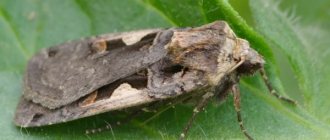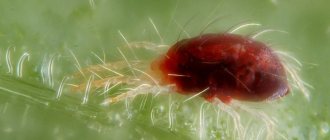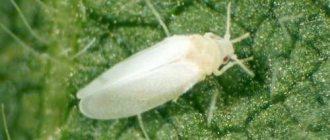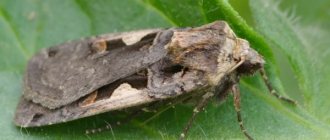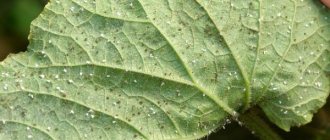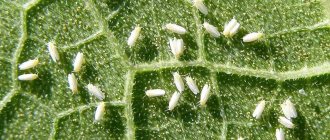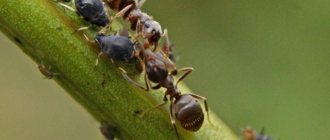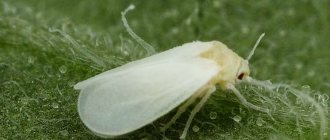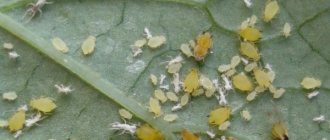A greenhouse is an excellent breeding ground for pests. High humidity and comfortable temperature promote favorable development of parasites. Aphids are considered especially dangerous. When it appears, you can say goodbye to 25% of the harvest. But there are a number of measures that will help get rid of the pest.
Signs of aphids in a greenhouse
Aphids in a greenhouse can be found on the undersides of plant leaves. It feeds on the sap of seedlings, causing the leaves to become dried out, curl and fall off. The ends of the shoots begin to bend, grow poorly and do not bear fruit.
The pest has wings and with their help is able to travel long distances, creating new colonies.
Aphid feeding is accompanied by the secretion of small sugar drops called “honeydew.” Such excrement attracts insects. Aphids get along well with ants. She provides them with food, and they provide her with protection.
Aphid recognition methods:
- Accumulations of parasites are visible on plants, especially on the lower part of the leaves;
- White marks (parts of old aphid skin) are visible on the leaves;
- Sticky traces – honeydew – are observed on the crops;
- The leaves deteriorate, curl, dry out;
- The plant stops bearing fruit, the buds remain closed.
Because of aphids, plants begin to get sick. The product they secrete attracts many other insects and pests. So white marks on the leaves are the result of yeast microorganisms.
Aphids are a real disaster for vegetable growers. If it gets into a greenhouse, then 25% of the plants die. It can appear in different ways. The pest can be carried in by the wind when ventilating the greenhouse. It can also occur with fertilizers, plant seedlings or soil.
Why do aphids appear in greenhouses?
Aphids in the greenhouse
Many gardeners are perplexed as to why aphids appear in the greenhouse. However, it is precisely these rooms with a damp microclimate that are conducive not only to the growth of seedlings, but also to the spread of pests. Aphids can enter a greenhouse structure while in the soil, on cuttings, or along with organic fertilizer that is used to treat seedlings. There is a chance for her to get pregnant during ventilation.
Having discovered a harmful insect, you must immediately begin to eliminate it. Otherwise, within a few days all plants growing in the greenhouse will be affected.
Folk remedies for fighting aphids in a greenhouse
Pest control began long before the advent of chemicals. Some remedies were more effective, others less so. But there are a number of folk recipes to destroy aphids.
Folk remedies will help not only get rid of pests, but also save on treatments. In addition, they are absolutely safe for fruits.
A means for combating aphids is prepared according to the following scheme: finely crushed, filled with water, filtered and sprayed on the plants. Depending on the chosen method, the proportions of water and infusion time change. At the same time, all folk remedies are quite accessible.
Infusions of plants that help fight aphids:
- Datura;
- Onion;
- Mustard;
- Marigold;
- Tobacco;
- Nettle;
- Garlic.
You can also prepare a tincture of pine needles and a decoction of tobacco dust. Some people also prefer to spray the crops with a solution of laundry soap and ash (you can take soda or any other alkali). You can try to collect the aphids yourself or wash them off with a stream of water. A significant disadvantage of folk remedies is that their period of action is longer than with chemical treatment. This is why they often resort to biological products.
Reasons for appearance
The melon or cotton aphid settles on cucumbers. This miniature insect reaches a length of 3-4 mm. The body of an adult is colored in various shades of green, the legs and antennae are black or dark brown. Not everyone has wings. The larvae are smaller and lighter in color. The development of one generation from the larva to the mature form lasts from 9 to 12 days.
The emergence of overwintered females begins at an air temperature of 12 ºC. In greenhouses and greenhouses, already at the beginning of May there is a risk of plantings being damaged by aphids.
The main reason for the appearance of insects in a greenhouse is ants, which carry them onto plants and protect them from predators. Increased temperature and humidity contribute to the prosperity and active reproduction of the pest.
Damage caused
Aphids feed on plant cell sap. Damaged leaf plates wrinkle and dry out. In the tissues of vegetables, the formation of nutrients necessary for growth and the formation of ovaries is disrupted. Uncontrolled reproduction of the pest leads to the death of the vegetable and complete loss of the harvest.
Another aspect of the harmfulness of aphids is the spread of cucumber mosaic virus.
Aphids can enter a greenhouse in several ways. Sometimes even the precautions taken do not save. You need to start fighting it immediately upon first detection, since many remedies cannot have an immediate result, and the insect will continue to destroy the crop for several more days.
Routes of entry:
- During ventilation of the greenhouse, small pests can fly inside and remain.
- Aphids can be found in organic fertilizers, so when fertilizing the soil in the greenhouse, the pest also penetrates into a new habitat.
- The insect waits out the winter inside the buds of the plant. When planting cuttings, they must be processed. Otherwise, in the spring there will be a lot of small insects in the greenhouse.
- Sometimes the pest enters the greenhouse when soil is added. It can also be infected.
Aphids in the greenhouse
Of the many species of aphids, only a few can live in a greenhouse:
- potato;
- melon or cotton;
- large potato;
- greenhouse or tobacco.
The speed at which aphids spread is amazing. Therefore, the longer measures to destroy it are absent, the greater the harm will be caused.
How to get rid of aphids in greenhouses using chemicals
Chemicals help eradicate pests in a greenhouse much faster. They can be purchased in wide access and assortment. The price of such drugs is quite affordable.
Chemicals act much faster than traditional medicine. After 2-4 hours, all aphids will be destroyed.
Each drug acts on a specific type of aphid. Before purchasing, it is important to determine which parasite is present on the plants in the greenhouse. This will ensure the effectiveness of processing, because each species has its own sensitivity to poisons.
Effective chemicals for controlling aphids:
- "Shar Pei";
- "Bitoxibacillin";
- "Kinmiks";
- "Aktofit";
- "Karbofos";
- "Fitoverim";
- "Intra-Vir".
Each drug has its own indications for use, which are prescribed in the instructions. Thus, it is necessary to treat crops with “Bitoxibacillin” 2-3 times during the growing season. Other medications need to be used once a week. Some should be used only a month before fruit appears. Each drug is individual, you need to study the instructions in detail before purchasing or consult with the seller.
But the chemicals have a destructive effect not only on aphids, but also on the soil. They are absorbed into the soil and remain there for a long time. Then the drugs are absorbed by water and vegetables and end up on the table. But chemicals also destroy beneficial microorganisms. Therefore, it is better to resort to folk remedies.
Pest control aphids
It is relatively easy to get rid of aphids in a greenhouse.
To do this, spray: you will need a bottle of dishwashing detergent (Fairy type) and a bottle of 70% food vinegar. For a bucket of water - 10 tsp. vinegar and 3 tbsp. l. dish liquids. The procedure can be carried out at any time. ATTENTION! Please note that you should use a sprayer with a flexible nozzle for the most effective treatment of entire plants. Don't forget that aphids are also located under the leaves. If there are a lot of insects, carry out the procedure several times at intervals of a couple of days.
Mechanical method
If you have black aphids in a greenhouse, you can remove the colony manually. If only a few aphids appear on the plants, remove them with a moistened cotton swab. Cut off severely affected leaves and buds and burn immediately.
Inside the greenhouse, aphids are carried by ants. Therefore, get rid of them as soon as possible (you can use anti-ant crayons).
Throughout the summer, destroy anthills not only inside the greenhouse, but also around it, in the adjacent area, and in the fall, dig up and fill them with salt solution or plain water.
In addition, during the season it is necessary to periodically eliminate weeds and plant plants at a distance from each other. And one more thing: be sure to get rid of linden and bird cherry. If you have them on your yard, you are unlikely to ever get rid of aphids.
Treatment with the following simple infusions will help against aphids in the greenhouse:
- Celandine - soak 300 g of dry leaves in a bucket of water, leave for 2 days.
- Dandelion - soak 1 kg of fresh leaves and roots in a bucket of water, leave for 3.5 hours.
- Garlic - pour half a kilo of chopped garlic into a 3 liter jar, add water, wait 5 days.
- Soaps with wood ash - 2 tablespoons of ash and grated laundry soap per bucket of water.
- Rhubarb - from black aphids.
In addition to the above, water infusions of plants such as marigolds, white mustard, dissected hogweed, creeping mustard, tobacco, nettle, garlic, and citrus fruits are suitable for fighting aphids. Among experienced gardeners, a popular remedy for pests is an infusion of pine needles or tops and leaves of tomatoes and potatoes.
In a greenhouse for bulbous flowers, you can use a solution of nitroammophoska (3 tbsp per bucket of water), in addition, it is a top dressing.
The aphids will quickly go away if you treat the glass of the greenhouse with a solution of copper sulfate. To be sure, you can also set fire to a sulfur bomb.
Read more about folk methods of fighting here!
Ecological way
Biological (or ecological) methods of aphid control include the use of plants and insects that can destroy and repel pests.
The ladybug is the most famous aphid exterminator. This cute-looking bug eats more than a hundred parasitic insects per day. It is very beneficial that ladybugs reproduce quite quickly (an individual lays up to 400 eggs). The eggs hatch into larvae, which in turn also feed on aphids.
The lacewing is not inferior in hunting aphids . This small insect is brown or greenish in color and has thin transparent wings. Lacewing larvae are very active all the time after sunset.
The larvae of the hoverfly are also lovers of aphids. Flies try to lay eggs closer to pest colonies. The hatched larvae, with an excellent appetite, eat all aphids found nearby. For hover flies, you should leave sweet clover, weedy umbrella plants and a few dill bushes around the greenhouse.
Excellent ethnophages are predatory gall midges, which are particularly sensitive to the location where aphids accumulate, are mobile and are always hungry.
Chemical method
If you are ready to exterminate harmful insects using other methods, then there are biological products and chemicals for aphids in the greenhouse to combat aphids.
- Biological products cause insect diseases and are capable of destroying the entire colony in 1 week. These insecticide preparations are: “Entobacterin”, “Fitoverma”, “Strela”, “Akarin”, “Biotlin” and others.
- Insecticides are divided into preparations of intestinal, contact and systemic action.
- Intestinal drugs - end up in the digestive system of the parasite, causing instant poisoning and death.
- Contact-action drugs are absorbed through the surface of the pest and immediately kill it. An example of such a drug is fufanon (karbofos).
- Systemic drug - penetrates immediately into all plant cells and remains in it for up to 4 weeks, without being washed off by rain or watering. Almost all systemic drugs have a short waiting period; although they are very convenient to use, they are also the most dangerous.
Combination drugs against aphids with contact-intestinal effects are often sold (for example: Akarin, Bankol, Actellik). They must be used with great caution. Modern systemic drugs: Aktara, Tanek, Biotlin.
Among chemical methods, it is possible to treat plants with a solution of the drug C-30 (dissolve 300 ml of the drug in 10 liters of water). Start treatment in early spring to effectively destroy aphid eggs.
Chemicals: Karbofos, Shar Pei, Inta-Vir, Kinmiks are recommended for the destruction of both larvae and adults. The necessary information is indicated in the instructions for the drugs. To avoid becoming addictive to the composition, alternate medications!
Work with chemical insecticides only in special protective clothing, goggles, gloves, and a respirator. They can only be used if all recommendations are strictly followed. Increasing the dose, as well as shortening the waiting period for the next treatment, will not provide you with a positive result. And taking into account their negative impact on health, it is better to use environmentally friendly products in small greenhouses.
ADVICE! While chemical protection against pests is undoubtedly effective, it is worth considering that toxic substances linger in the soil for a long time and beneficial insects are destroyed. Do not overuse chemicals unless absolutely necessary - after all, along with the pests, you will also destroy their enemies: ladybugs and lacewings, hoverflies and earwigs, ichneumon wasps and ground beetles, predatory bugs, etc.
From the above we can conclude: time will tell what helps against aphids in a particular situation! But the main thing is not to sit still and wait for the plants to completely die!
How to treat a greenhouse against aphids: preventive measures
To reduce crop losses and maintain proper soil microflora, you need to take preventive measures against aphids. At the same time, it is impossible to get rid of the pest forever, but you can protect yourself with a number of measures. These are different agrotechnical and organizational measures.
Preventive measures to combat aphids:
- All weed and plant remains should be removed and burned;
- It is necessary to regularly remove all weeds on which aphids can form;
- Crops that are most often infested by pests should be located away from poppy, viburnum, linden or mallow;
- It is necessary to periodically inspect the stems for the presence of aphids;
- The greenhouse must be ventilated so that the plants receive fresh air;
- Watering should be done only with warm water - 25 degrees;
- Before planting plants in the spring, you need to treat all greenhouse equipment and items with bleach or caustic soda;
- The interior of the greenhouse should be treated with sulfur gas.
After the growing season is over, more serious methods can be used. The crops should be treated with a mixture of insectoacaricide and 40% formaldehyde solution. It is worth remembering that many pests may like the greenhouse climate, so the greenhouse must be ventilated regularly.
Preventative work: how to fight aphids in a greenhouse (video)
Aphids can appear in absolutely any greenhouse. It settles on the bottom of the leaves and gradually sucks the life out of the crops. Various methods are used to combat it. Folk remedies are safer, but chemicals are fast-acting. To protect yourself from the appearance of an unpleasant pest, you need to take a number of preventive actions.
- Author: admin
Rate this article:
- 5
- 4
- 3
- 2
- 1
(2 votes, average: 5 out of 5)
Share with your friends!
Reviews
Lyudmila, Samara: “On principle, I try not to use chemicals at my dacha. My proven method against aphids is potato tops. I fill a kilogram of tops with a bucket of water and let it brew for 3–5 hours. I filter, add a little liquid soap and spray the cucumbers. It is important not to overdo the concentration: the tops are highly poisonous and can cause burns on the leaves.”
Yulia, Moscow region: “I have been using the drug “Fitoverm” for several years. I dilute it strictly according to the instructions. After a few days, there are no living adult aphids left, but eggs remain. Therefore, after about a week or 10 days I repeat the treatment. To consolidate the effect, I spray it again after a couple of weeks. This is enough for a season.”

